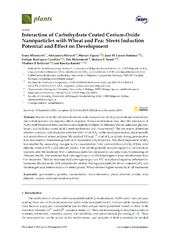| dc.creator | Milenković, Ivana | |
| dc.creator | Mitrović, Aleksandra D. | |
| dc.creator | Algarra, Manuel | |
| dc.creator | Lázaro-Martínez, Juan M. | |
| dc.creator | Rodríguez-Castellón, Enrique | |
| dc.creator | Maksimović, Vuk | |
| dc.creator | Spasić, Slađana Z. | |
| dc.creator | Beškoski, Vladimir | |
| dc.creator | Radotić, Ksenija | |
| dc.date.accessioned | 2019-11-28T12:47:17Z | |
| dc.date.available | 2019-11-28T12:47:17Z | |
| dc.date.issued | 2019 | |
| dc.identifier.issn | 2223-7747 | |
| dc.identifier.uri | https://cherry.chem.bg.ac.rs/handle/123456789/3698 | |
| dc.description.abstract | Reports about the influence of cerium-oxide nanoparticles (nCeO2) on plants are contradictory due to their positive and negative effects on plants. Surface modification may affect the interaction of nCeO2 with the environment, and hence its availability to plants. In this study, the uncoated and glucose-, levan-, and pullulan-coated nCeO2 were synthesized and characterized. The aim was to determine whether nontoxic carbohydrates alter the effect of nCeO2 on the seed germination, plant growth, and metabolism of wheat and pea. We applied 200 mgL-1 of nCeO2 on plants during germination (Ger treatment) or three week-growth (Gro treatment) in hydroponics. The plant response to nCeO2 was studied by measuring changes in Ce concentration, total antioxidative activity (TAA), total phenolic content (TPC), and phenolic profile. Our results generally revealed higher Ce concentration in plants after the treatment with coated nanoparticles compared to uncoated ones. Considering all obtained results, Ger treatment had a stronger impact on the later stages of plant development than Gro treatment. The Ger treatment had a stronger impact on TPC and plant elongation, whereas Gro treatment affected more TAA and phenolic profile. Among nanoparticles, levan-coated nCeO2 had the strongest and positive impact on tested plants. Wheat showed higher sensitivity to all treatments. | |
| dc.publisher | MDPI | |
| dc.relation | info:eu-repo/grantAgreement/MESTD/Integrated and Interdisciplinary Research (IIR or III)/45012/RS// | |
| dc.relation | info:eu-repo/grantAgreement/MESTD/Integrated and Interdisciplinary Research (IIR or III)/43004/RS// | |
| dc.relation | info:eu-repo/grantAgreement/MESTD/Basic Research (BR or ON)/173040/RS// | |
| dc.relation | info:eu-repo/grantAgreement/MESTD/Basic Research (BR or ON)/173017/RS// | |
| dc.relation | info:eu-repo/grantAgreement/MESTD/Basic Research (BR or ON)/173045/RS// | |
| dc.relation | project RTI2018-099668-BC22 of Ministerio de Ciencia, Innovación y Universidades | |
| dc.relation | ARDITI-Agência Regional para o Desenvolvimento da Investigação Tecnologia e Inovação, project M1420-01-0145-FEDER-000005 - Centro de Química da Madeira - CQM+ | |
| dc.rights | openAccess | |
| dc.rights.uri | https://creativecommons.org/licenses/by/4.0/ | |
| dc.source | Plants | |
| dc.subject | Phenolic profile | |
| dc.subject | Total phenolic content | |
| dc.subject | Characterization | |
| dc.subject | Germination | |
| dc.subject | Growth | |
| dc.subject | Nanomaterial | |
| dc.subject | Plant | |
| dc.subject | Total antioxidative activity | |
| dc.title | Interaction of carbohydrate coated cerium-oxide nanoparticles with wheat and pea: Stress induction potential and effect on development | |
| dc.type | article | |
| dc.rights.license | BY | |
| dcterms.abstract | Лáзаро-Мартíнез, Јуан М.; Родрíгуез-Цастеллóн, Енриqуе; Максимовић, Вук; Спасић, Слађана З.; Бешкоски, Владимир; Миленковић, Ивана; Радотић, Ксенија; Aлгарра, Мануел; Митровић, Aлександра; | |
| dc.citation.volume | 8 | |
| dc.citation.issue | 11 | |
| dc.identifier.wos | 000502258800042 | |
| dc.identifier.doi | 10.3390/plants8110478 | |
| dc.citation.rank | M21~ | |
| dc.description.other | Supplementary material: [http://cherry.chem.bg.ac.rs/handle/123456789/3699] | |
| dc.type.version | publishedVersion | |
| dc.identifier.scopus | 2-s2.0-85074654761 | |
| dc.identifier.fulltext | https://cherry.chem.bg.ac.rs/bitstream/id/16203/Interaction_of_Carbohydrate_pub_2019.pdf | |


